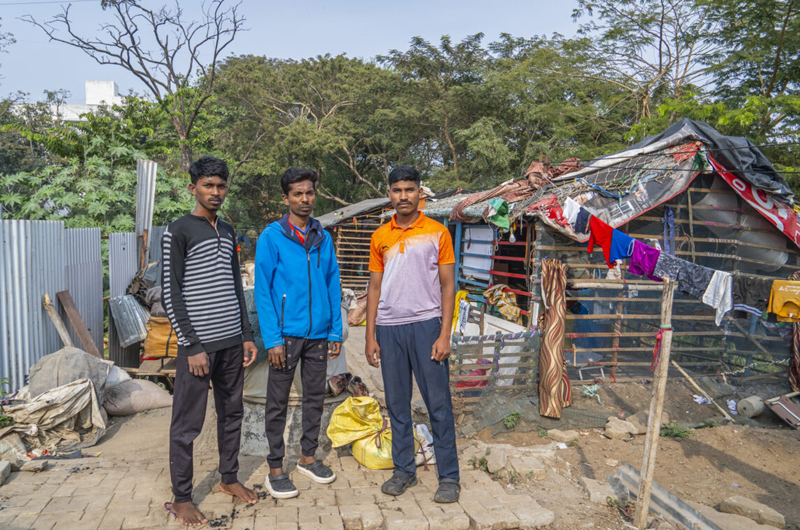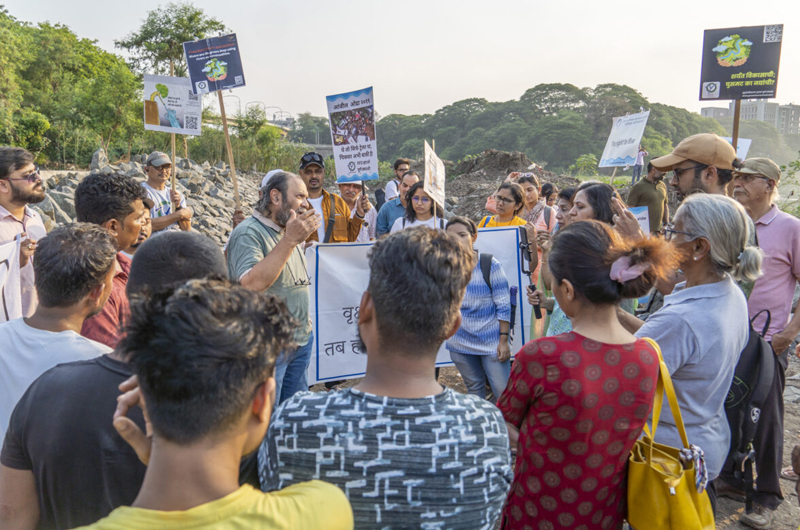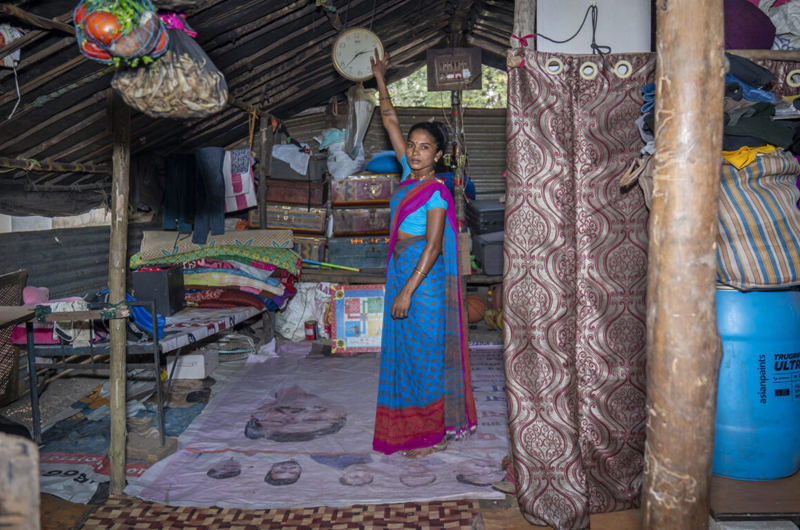Floods that occurred in 2024 continue to impact people living in informal settlements across Pune. There has been significant loss of property and continued issues of hygiene and health of the urban working poor. The citizens demand early warnings, better facilities at rehabilitation sites, and greater consideration of the health impacts of floods on their lives. Experts suggest addressing flood risks by increasing river capacity and responsible urban planning. A detailed report by Apsara Aga and Vinaya Kurtkoti
The Mutha River flows through the Tapodham area in Pune, where a small settlement of the Potraj Community lives in an overlooked and hard-to-reach cluster of huts along the riverbank. On July 24 last year, torrential rains hit the area at night, disrupting life. “We were asleep when we suddenly felt our blankets turn wet. We woke up at 3 am to see our home submerged in water. Though this was not the first time our huts were filled with water, we did not know how to respond as the water level began to rise,” shares Kavita Nimbalkar, a 25-year-old homemaker from the community.
The water gradually filled the house and reached up to their knees. “We got our small children out of the house first, then we tried to get the sheep and chickens. As the water levels kept rising, we somehow managed to escape. Two of our sheep were washed away, and so were the chickens. The men swam through the water, trying to save whatever they could grab, but essential government documents, household items, and several pets were lost to the flood.”
Amidst the downpour, then Maharashtra Chief Minister Eknath Shinde ordered the evacuation of residents living within the river’s blue line, which marks the flood level expected over a 25-year period. The areas are considered vulnerable to floods. Around 4,000 residents from various areas within the blue line were evacuated to safety by the Pune Municipal Corporation (PMC).
Satish Nimbalkar (28), another member of the Potraj Community, was evacuated with his family of five. Nimbalkar, originally from Baramati, moved to Pune 14 years ago. “We were staying in Chaudhari School where the Municipal Corporation had given us shelter, but six families were crammed into just two rooms. We swam through the flood to save our two sheep and three chickens but didn’t have place to keep them. We’ve lived in Pune for 14 years and never seen water levels this high. This time, the loss is enormous,” he said.
Shakuntala Nimbalkar (45), also from the Potraj Community, says she lost all her belongings due to the flood. She was rehabilitated at the school for more than 15 days. “We feel like we are living in a state of exile. We had no access to education, but somehow three of my children are studying now. Our hut was full of water; we will have to rebuild it now. My family begs in the name of Mari Aai all day and make rupees 200-250 daily, and now even this source of income has stopped. We cannot go out until the rain subsides. We are going to struggle for food. Who will help us? When a flood warning is issued, why don’t they inform us in advance?” she told Mongabay India during an interview at the temporary shelter.
This community that lives in Pune is known as Kadak Lakshmi in some parts of Maharashtra, Potraj in others, and Mariamwale elsewhere. In Maharashtra, they are classified as part of nomadic tribes, and in Madhya Pradesh they fall under the Scheduled Tribe Category. The community typically makes a living by performing folk art on the streets for audiences who contribute what they can. Their traditional attire usually includes brightly coloured clothes, long hair, turmeric and vermillion on their foreheads, and a waist belt made of ankle bells. They carry a long whip in their hands. On average, they earn around Rs 300-400 daily. Some individuals have now moved on from the traditional profession and work as waiters, drivers or watchmen, earning between Rs 6,000 and Rs 8,000 per month. Many of the youth are the now the first generation of Potraj families that is pursuing education.

Vulnerable citizens
Another settlement in Pune that was flooded last year is in the Tadiwala Road area that lies along the Mula-Mutha River formed by the confluence of the Mula and Mutha Rivers and traverses across Pune city. The Tadiwala Road settlement, densely packed with houses, is a few kilometres away from the city’s main railway station and some of the affluent neighbourhoods of the city. It is home to many people who work the city’s informal service sector. Over time, the settlements have expanded downwards from the main road toward the riverbank. Nita Waghmare (35, name changed), a member of the community who works as a security staff in a hospital, says, “Our house got flooded twice. The first time, we didn’t even realise what was happening. There was no warning. The water suddenly rushed in and caused a lot of chaos.”
Waghmare’s house is at the end of a narrow lane. The water came in from the street and flooded her home completely. “We grabbed whatever belongings we could and rushed out. We had to save lives first, right? I have three children — who else would look after them?” she asked. This was not the first time Waghmare’s house was flooded. Whenever Pune experiences torrential rain, her house is flooded with sewage; insects and worms infest the place. “The authorities know that this settlement floods every year, so why don’t they do anything for us?” she added.
K.S. Hosalikar, scientist ‘G’ and head of Climate Research & Services at the India Meteorological Department (IMD) in Pune, states that flood forecasting is managed by the Central Water Commission, which relies on various meteorological inputs from IMD. IMD has also developed a South Asia flood warning system available on its website, providing real-time flood inundation guidance in graphical form. Based on this data, IMD issues flood guidance to all stakeholders in addition to regular forecasts. However, there is always room for improvement for which IMD always strives, he said.
IMD has an Urban Meteorology Scheme that addresses urban meteorology issues, including flood warning systems developed and implemented in cities like Mumbai and Chennai. When asked about the concerns of the slum dwellers regarding early warnings being issued to them, Hosalikar shared that while early warning is issued by IMD in all formats, it is also the responsibility of other stakeholders to ensure that the warnings reach the last mile. “We have several applications in local languages, social media and many other platforms to reach out to all of them. An integrated approach with all stakeholders including media is key to ensuring that the information reaches the last mile,” he said.
After the flood
Patil Estate, an informal settlement, also situated on the banks of the Mula-Mutha River, gets flooded every year. A settlement of 1,100 houses built of tin sheets, it has a population exceeding 7,000. After the water receded this year, people from Patil Estate returned home from the government-provided temporary shelters. Reshma Kamble (43), who works as domestic help, recalls, “When we came back, our house was full of mud. The drainage lines carrying sewage outside were not cleaned, despite our requests. Cleaning the house was a huge struggle, and the municipal corporation didn’t send anyone to help.”
Shabana Sheikh, another resident of Patil Estate, shares that the flood water reached knee-level inside their home this year. Sheikh lives in a small room, with another room above it, with her husband and three children. Her husband drives a rickshaw, which is how they support their family of five. “We were given temporary shelter at a school, but how many of us could have fit there? There was no space to sit or sleep. We spent the days at the temporary shelter just sitting around, unable to work,” she said.
After the floods subsided, the chief minister visited the areas and assured that the settlements would be cleaned and ration (subsidised food grains) would be provided. Sheikh shares that they had to remove the knee-deep filth from their homes themselves, and they have received no ration from the government. “There’s still a stench in our house, and it’s infested with rats and insects. Is anyone thinking about the impact these floods are having on our health?” she asks.
Vanita Kamble (name changed) shares that after cleaning out their homes, their health has been affected. “Every day, one of us has to go to the hospital for aches and pains. There are drainage lines in front of our homes, which led to a mosquito problem. They’re not cleaned on time, and no fogging to repel mosquitoes is done. The Municipal Corporation isn’t paying any attention to our health,” she says.
Pratima Joshi, founder and executive director of Shelter Associates, an NGO that works for the betterment of the lives of the urban poor, shared that as a result of recurring floods, people were reluctant to make investments in their homes even though they had been residing in Pune for years. “Kaccha (temporary) houses were not built into pucca (permanent) houses for years, because people fear their investment would be wasted. During floods, people had no choice but to move to nearby government schools as their homes would be completely submerged. After a few weeks, they would return to homes filled with muck, which became a huge task to clean, and this was mostly done by women. The houses would be overrun with snakes, insects, and a stench that lingered for weeks, even after the water had receded,” she said.

flooding in Pune.
Riverfront project brings new challenges
PMC initiated a riverfront development (RFD) project in 2022. One of the objectives of the project is to build embankments to protect the citizens against flooding. The project, estimated to cost around Rs 5,500 crore, aims to reduce the impact of human-made obstacles on the river’s flow. Despite the significant expenditure, many residents in various informal settlements along the river, have shared that rainwater still entered their homes and complained that the riverfront development project has negatively impacted their lives.
According to PMC Disaster Management Cell, heavy rains in July caused flooding in Patil Estate and other areas twice. Being situated along the riverbank, Patil Estate was severely affected, with many residents’ belongings damaged. When asked about rehabilitation, the Disaster Management Cell said that the responsibility to rehabilitate people living in the flood zones rests with the Construction Department. According to the PMC Construction Department, the rehabilitation work has now been transferred to the SRA (Slum Rehabilitation Authority). As per government regulations, the size limit for new houses is set at 300 square feet. However, the residents of the settlement are demanding 550 square feet. As a result, SRA has halted the work.
Meanwhile, the Pimpri-Chinchwad Municipal Corporation (PCMC), another civic body that governs the Pimpri Chinchwad area of the larger Pune Metropolitan Region, has planned the demolitions of illegal constructions in the blue line of the Mula River. Sarang Yadwadkar, Pune-based environmentalist and architect, says that this year (2024), Mutha River’s discharge from the Khadakwasla Dam was 35,570 cusecs, while its blue line is defined for 60,000 cusecs. Although the discharge increased due to rainwater runoffs from the free catchment area, it remained below 60,000 cusecs. The blue line was crossed due to two main flaws in the floodline defined in 2011: they did not account for flows from the free catchment area and the confluence effect, where merging rivers slow down and create upstream pressure. Secondly, narrowing of the river by channelisation for the RFD project caused the blue line to be breached.
Historically, even higher flows (67,000 cusecs in 2014 and 90,000 cusecs in 1997) did not cause significant flooding. However, the 2024 floods with lower discharges raised concerns about increasing encroachments in the riverbed — both legal and illegal — that restrict river flow. “Encroachments include debris dumped to expand land and riverfront developments that have narrowed the river significantly. Just like traffic slows down at a busy junction where two roads meet, the velocity of the water reduces when two rivers meet. This causes back pressure on the upstream leading to rise in flood levels. This is how all the areas flooded this year were upstream of the RFD, highlighting the failure of RFD to manage water flow effectively,” Yadwadkar explained.
Girish Patil, founder of Youth Organisation for Green India, explained how the narrowing of the river caused by concretisation on both sides has slowed down its flow. “Both climate change and poor urban planning are at fault. The claim that the river improvement project caused water to enter settlements is valid,” he shared. Experts believe that repeated flooding in these areas will not stop unless the carrying capacity of the river is increased. Shailaja Deshpande of Jeevitnadi says, “Regulations prohibit construction in the blue flood zone and between the blue and red zones, allowing building only beyond the red line. However, this information hasn’t reached the public, leading to extensive construction in flood-prone areas. A wall won’t stop floodwaters; there must be proper drainage. The solution lies in increasing the flood-carrying capacity of rivers, streams, and tributaries, along with rainwater harvesting and borewells. Rehabilitation of those in flood zones as per regulations is essential.”

Building the embankments along the river ensured that the rainwater that accumulated along the riverbanks in homes could not flow back into the river, say the residents of these communities. The administration should have made provisions for the water to flow back into the river. “Despite environmental experts opposing the riverfront development project, instead of spending excessive amounts on this project, the administration should have focused on reviving the river, increasing its carrying capacity, and creating natural green zones. The city is already experiencing the consequences of climate change, and the administration should be spending on projects that would help reduce these impacts,” says Deshpande.
Pratima Joshi shared that Shelter Associates has created a database of Pune’s slums, and found that approximately 40 per cent of Pune slums are either very close to or in the riverbed or along the river or canals. “There is no dearth of data on Pune slums. The authorities have to systematically start looking for ways to relocate people living in areas that get flooded yearly. However, such relocation must be done taking the people into confidence and with the participation of the community,” she said.
Flooding has occurred in Shaniwar Peth, Pulachi Wadi, Rajput Vasti, and Ekta Nagari along Sinhagad Road, all located upstream of the RFD, Yadwadkar shared. The only significant change since 2019 has been the RFD. The RFD has reduced the river’s width by 38%. This has drastically decreased the river’s carrying capacity after the confluence.
The municipal corporation initiated the riverfront improvement project in March 2022. Environmental activists campaigned against it, prompting Yadwadkar to file a petition with the National Green Tribunal (NGT). PMC submitted a report to the State Environment Impact Assessment Authority (SEIAA) for modified environmental clearance. During a SEIAA hearing, PMC’s draft was approved, granting the necessary environmental clearance. This approval was submitted to the NGT, which subsequently dismissed Yadwadkar’s petition. As a result, work on the project can now continue.
(Courtesy: Mongabay India/ india.mongabay.com.)



 from Webdoux
from Webdoux